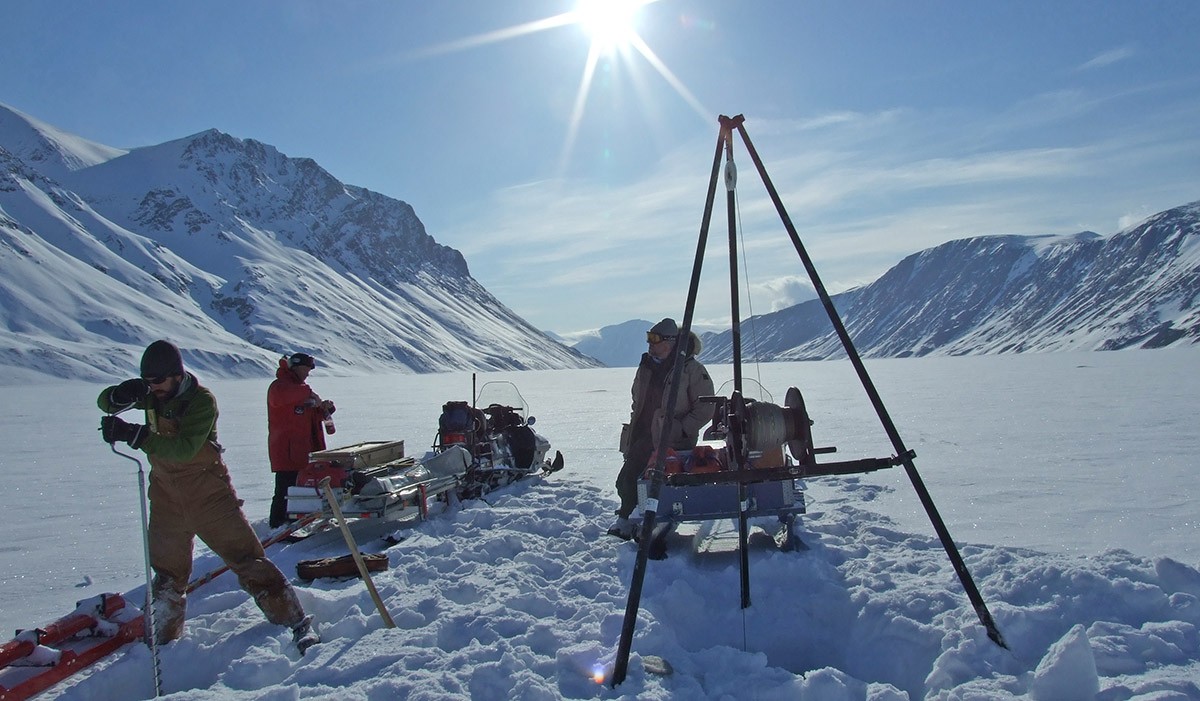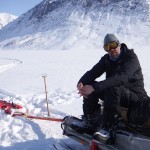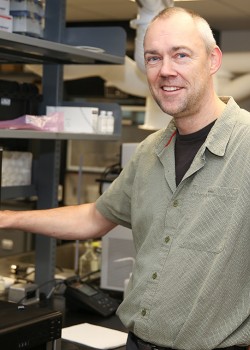
ASP team members using tripod to lower instruments and deploy moorings in the sea ice during fieldword in Daneborg, Northeast Greenland, June 2014. Photo by Igor Dmitrenko
Arctic Partners
Dynamic trio brings together world's leading arctic climate scientists
On June 8, 2012, University of Manitoba President David Barnard was in Greenland’s capital city of Nuuk to sign an agreement with colleagues from other Arctic nations. The trip happened with little or no fanfare—but when he signed the Arctic Science Partnership (ASP) Memorandum of Understanding, it amplified the research opportunities and impact of our students and faculty.
The partnership brings together more than 300 of the world’s leading Arctic scientists from the greatest Arctic science teams: Denmark’s Aarhus University, Greenland’s Institute of Natural Resources and the U of M’s Centre for Earth Observation Science (CEOS) in the Clayton H. Riddell Faculty of Environment, Earth, and Resources.
Collaborators will share expertise, knowledge and infrastructure; equipment, laboratories, research vessels and field stations are now mutually available to all, allowing students to work across all research institutions.
The bolstered work covers a wide range of topics, from health sciences to socio-economics to environmental and climate-related issues. The collaboration is also a response to the increasing pressures faced by the Arctic.
“The Arctic faces enormous changes. Its climate is changing dramatically, while interest in exploring for oil, gas and minerals in the Arctic regions is increasing,” says Barnard.
“To deal effectively with the new challenges these changes present, it is critical that we collaborate with our international partners to remain at the front and centre of this endeavour. The sheer complexity of the Earth systems in the Arctic required us to join our resources with our friends and colleagues from around the world. The U of M has been doing this for years—as when we led the circumpolar flaw lead system study—and it’s rewarding to continually collaborate with such excellent partners.”
The University of Manitoba has committed to ASP through the work of CEOS and its two powerhouse research chairs: Søren Rysgaard, the Canada Excellence Research Chair (CERC) in Arctic Geomicrobiology and Climate Change, and David Barber, the Canada Research Chair in Arctic System Science.
Rysgaard and CEOS director Tim Papakyriakou lead ASP collaboration in Canada and are both convinced that ASP is quickly becoming internationally recognized as a preeminent force, attracting students and researchers from around the world who want to contribute to a large-scale, international effort at the highest scientific level.
“ASP gives us an enormous, very valuable, logistical platform, which offers our employees and students easy and low-cost access to icebreakers, research vessels and research stations in the Arctic area—something usually not easily attainable,” says Rysgaard.
For students, this means increased opportunities to participate in international scientific expeditions and field campaigns, and access to academic programs across all three institutions including an annual ASP Field School.
In 2015, the university will send students to Nuuk (Greenland) to join an international team of 15 graduate students to learn more about the role snow-covered sea ice plays in the Arctic system. The field school, hosted at the Greenland Institute for Natural Resources, also aims to engage the local communities by developing and implementing an outreach program for local students, and by including elders as instructors.
Kerri Warner, a research associate in CEOS, can easily point to the new opportunities and resources created through the partnership. In May, 2014, Kerri worked at the Daneborg Research Facility, which is in the world’s largest National Park, situated in northeast Greenland. Her research there focused on collecting data and analyzing how the surface albedo (how well sunlight—energy—gets reflected back into space) changes during the melt progression. She also measured changes in the geophysical properties of the snow and ice as temperatures continue to warm into summer. Her data supports myriad other scientists looking at other aspects of Arctic life from biology to contaminants.
“While the data collection is the main reason for going out in the field,” she writes in a blog, “it is the places you go, the people you meet, the moments you share and friendships that develop in such a short that time make it a life-changing experience.
“When people in any part of the world decide to study sea ice, our university will be their first school of choice because we are the world’s top institute.”
“You start as a group of strangers who have to live with each other in a tight living space for weeks at a time, and end with hugs, well wishes and emotional farewells by the time it is over. You discuss ways in which your research can contribute to theirs and vice-versa. These 10 strangers have developed not only collaborative research relationships, but also friendships. We all share that ‘little bit crazy’ quality that takes us away from home for long periods of time to work and to research things that we are all so passionate about.”
Our Pedigree
Of all the founding partners of ASP, the U of M’s is the oldest.
Founded in 1994, CEOS has a major research focus on Arctic science, studying the physical, chemical, biological, and human systems of the Canadian and Circumpolar Arctic.
In 2010, when the CERC funding was announced, the sea ice research group was transformed into one of the world’s most comprehensive and innovative Arctic climate change institutions. In addition to the 17 researchers already involved in the sea ice research, an investment was made in new laboratories, three new tenure track faculty positions, post-doctoral and research associate positions, graduate students and support staff. It increased the size of CEOS to more than 100 people.
To accommodate the new faculty, staff and students, the Wallace Building underwent major renovations thanks to a generous donation from distinguished geological sciences graduate Clayton H. Riddell, for whom the faculty is named. An entire fifth storey was added to the building to house the many specialized state-of-the-art laboratories, meeting spaces, offices for staff and students, and the Dr. Klaus Hochheim Memorial Theatre. This new floor is named the Nellie Cournoyea Arctic Research Facility, after Nellie Cournoyea, an officer of the Order of Canada, the first female premier of a Canadian territory, and Chair and CEO of the Inuvialuit Regional Corporation.
Since CEOS transformed, says Digvir Jayas, Vice-President (research and international) at the U of M, its sea ice research team has become one of the most well-funded and extensive teams in the world, conducting research both in the Arctic and at home. The Sea-Ice Environmental Research Facility (SERF), is the first experimental sea-ice facility in Canada and only one of a few facilities in the world that allows researchers to grow and fabricate sea ice in controlled conditions to better understand how sea ice forms and melts in polar regions.
“When people in any part of the world decide to study sea ice, our university will be their first school of choice because we are the world’s top institute,” he added.
The U of M’s sea ice research team, unlike the ice they study, is not retreating from anything. It’s only moving forward, and with its new partners, growing stronger.
Story originally appeared in the Winter 2015 issue of Research Life.








